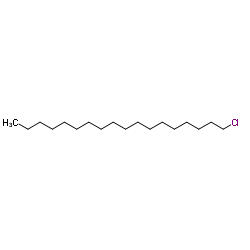Incorporation of 1-chlorooctadecane into FA and beta-hydroxy acids of Marinobacter hydrocarbonoclasticus.
Elisabeth Aubert, Pierre Metzger, Claude Largeau
文献索引:Lipids 39(1) , 75-9, (2004)
全文:HTML全文
摘要
The lipids of the gram-negative marine bacterium Marinobacter hydrocarbonoclasticus, cultivated in synthetic seawater supplemented with 1-chlorooctadecane as sole source of carbon, were isolated, purified, and their structures determined. Three pools of lipids were isolated according to the sequential procedure used: unbound lipids extracted by organic solvents, ester-bound lipids released under alkaline conditions, and amide-bound lipids released by acid hydrolysis. FA isolated from the unbound lipids included omega-chlorinated (21%, w/w, of this fraction; C16 predominant) and nonchlorinated compounds (22%, w/w; C18 predominant). These acids were accompanied by a high proportion of omega-chloro-C18 alcohols (43%, w/w) and a lower amount of omega-chloro-beta-hydroxy-C18, -C16, and -C14 acids (5%, w/w). These data, together with the isolation from the culture medium of gamma-butyrolactone, suggested a metabolism of 1-chlorooctadecane through oxidation into omega-chloro acid and then the classic beta-oxidation pathway. The analysis of the ester-bound and amide-bound lipids revealed that significant amounts of omega-chloro-beta-hydroxy C10-C12 acids were incorporated into the lipopolysaccharides of the bacterium. Incorporation of these omega-chloro-beta-hydroxy acids into the lipopolysaccharides represents a novel route for chloroalkane assimilation in hydrocarbonoclastic gram-negative bacteria. The formation of chlorinated hydroxy acids, like the omega-chloro FA in the cellular lipids, could account for an incomplete mineralization of chloroparaffins in the environment.
相关化合物
| 结构式 | 名称/CAS号 | 分子式 | 全部文献 |
|---|---|---|---|
 |
氯代十八烷
CAS:3386-33-2 |
C18H37Cl |
|
Variations in pH sensitivity, acid stability, and fusogenici...
2015-01-01 [J. Virol. 89(1) , 350-60, (2014)] |
|
Fluorescent sensors for the basic metabolic panel enable mea...
2014-10-21 [Analyst 139(20) , 5230-8, (2014)] |
|
Cathepsin W Is Required for Escape of Influenza A Virus from...
2015-01-01 [MBio 6 , e00297, (2015)] |
|
Incorporation of chlorinated alkanes into fatty acids of hyd...
1983-12-01 [J. Bacteriol. 156(3) , 1158-64, (1983)] |
|
Hydrophobically-modified poly(vinyl pyrrolidone) as a physic...
2015-08-01 [Exp. Eye Res. 137 , 18-31, (2015)] |